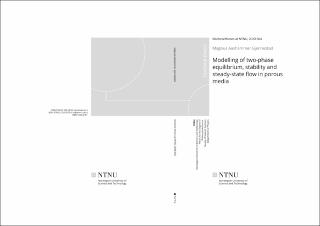| dc.contributor.advisor | Hansen, Alex | |
| dc.contributor.advisor | Kjelstrup, Signe | |
| dc.contributor.advisor | Wilhelmsen, Øivind | |
| dc.contributor.author | Gjennestad, Magnus Aashammer | |
| dc.date.accessioned | 2020-11-13T14:00:34Z | |
| dc.date.available | 2020-11-13T14:00:34Z | |
| dc.date.issued | 2020 | |
| dc.identifier.isbn | 978-82-326-5075-0 | |
| dc.identifier.issn | 1503-8181 | |
| dc.identifier.uri | https://hdl.handle.net/11250/2687856 | |
| dc.description.abstract | This thesis concerns fundamental aspects of coexistence and flow of two fluid phases within porous media. Specifically, the focus is on thermodynamic stability and equilibrium on the scale of a single pore and on macroscopic steady-state properties of immiscible two-phase flow. In this work, macroscopic steady-state properties refers to time-averages of time dependent quantities that describe flow through a volume element consisting of many pores.
Capillary models are derived for free and adsorbed droplets and bubbles, and thick films in a pore. The thermodynamic stability of these structures in a specific pore geometry is mapped out and the effect of pore size and the pore being open or closed w.r.t. exchange of particles with the surroundings is explored. Equilibrium structures are found. When structures are unstable, they are found to be unstable against perturbations that can be classified as either translation or as condensation/evaporation. Furthermore, stability of thin films and droplets on a flat solid surface is considered. It is found that the often-cited criterion for stability of a flat film, which states that the flat films are stable when the derivative of disjoining pressure w.r.t. film thickness is negative, applies in open systems. In closed systems, however, stability is governed by mechanical instabilities that require a large enough substrate size to render the film unstable. Unstable droplets in both the open and closed containers are found to represent saddle points and activation barriers in their respective energy landscapes.
Numerical methods are presented that enable stable and fast time integration of a pore network model. These eliminate previous problems with numerical instabilities observed at low capillary numbers. The new methods extend the range of capillary numbers for which the pore network model is a tractable alternative and enables e.g. future studies of Haines jumps in the low capillary number regime.
By pore network modelling and lattice-Boltzmann simulations in the high capillary number limit, it is found that the total flow rate follows a Darcy-type equation where the fluid viscosity is replaced by an effective viscosity. This effective viscosity can be modelled by
the Lichtenecker-Rother equation. Results from more than 6000 steady-state simulations using the pore network model are presented that range from the high capillary number limit and down to ~10-4. Variation in dimensionless output from the model is shown to be explainable by three dimensionless variables: the wetting fluid saturation, the viscosity ratio and a dimensionless pressure gradient. In the high capillary number limit, the model gives relative permeabilities that do not form straight lines when the viscosity ratio is different from one.
This thesis also addresses the computational challenges associated with calculating the thermodynamic stability limits of multi-component mixtures and the identification of extrema as minima, maxima or saddle points in variational calculus. | en_US |
| dc.language.iso | eng | en_US |
| dc.publisher | NTNU | en_US |
| dc.relation.ispartofseries | Doctoral theses at NTNU;2020:364 | |
| dc.relation.haspart | Paper 1: Aursand, Peder; Gjennestad, Magnus Aashammer; Aursand, Eskil; Hammer, Morten; Wilhelmsen, Øivind. The spinodal of single- and multi-component fluids and its role in the development of modern equations of state. Fluid Phase Equilibria 2016 ;Volum 436. s. 98-112
https://doi.org/10.1016/j.fluid.2016.12.018
This is an open access article under the CC BY-NC-ND license (CC BY-NC-ND 4.0) | en_US |
| dc.relation.haspart | Paper 2: Gjennestad, Magnus Aashammer; Wilhelmsen, Øivind. Thermodynamic stability of droplets, bubbles and thick films in open and closed pores. Fluid Phase Equilibria 2019 ;Volum 505.
https://doi.org/10.1016/j.fluid.2019.112351
This is an open access article published under a Creative Commons Attribution (CC-BY) | en_US |
| dc.relation.haspart | Paper 3: Gjennestad, Magnus Aashammer; Wilhelmsen, Øivind. Thermodynamic Stability of Volatile Droplets and Thin Films Governed by Disjoining Pressure in Open and Closed Containers. Langmuir 2020 ;Volum 36.(27) s. 7879-7893
https://doi.org/10.1021/acs.langmuir.0c00960
This is an open access article published under a Creative Commons Attribution (CC-BY) | en_US |
| dc.relation.haspart | Paper 4: Gjennestad, Magnus Aashammer; Vassvik, Morten; Kjelstrup, Signe; Hansen, Alex. Stable and efficient time integration of a dynamic pore network model for two-phase flow in porous media. Frontiers in Physics 2018 ;Volum 6
This is an open-access article distributed under the terms of the Creative Commons Attribution License (CC BY)
https://doi.org/10.3389/fphy.2018.00056 | en_US |
| dc.relation.haspart | Paper 5: Sinha, Santanu; Gjennestad, Magnus Aashammer; Vassvik, Morten; Winkler, Mathias; Hansen, Alex; Flekkøy, Eirik Grude. Rheology of high-capillary number two-phase flow in porous media. Frontiers in Physics 2019 ;Volum 7.(65
https://doi.org/10.3389/fphy.2019.00065
This is an open-access article distributed under the terms of the Creative Commons Attribution License (CC BY) | en_US |
| dc.relation.haspart | Paper 6: Gjennestad, Magnus Aashammer; Winkler, Mathias; Hansen, Alex. Pore Network Modeling of the Effects of Viscosity Ratio and Pressure Gradient on Steady-State Incompressible Two-Phase Flow in Porous Media. Transport in Porous Media 2020
https://doi.org/10.1007/s11242-020-01395-z
This article is licensed under a Creative Commons Attribution 4.0 International License (CC BY 4.0) | en_US |
| dc.title | Modelling of two-phase equilibrium, stability and steady-state flow in porous media | en_US |
| dc.type | Doctoral thesis | en_US |
| dc.subject.nsi | VDP::Mathematics and natural science: 400::Physics: 430 | en_US |
